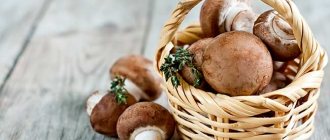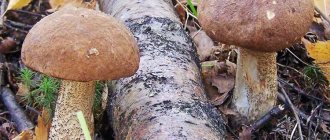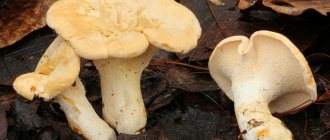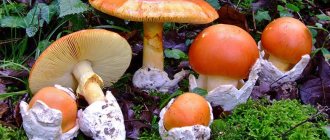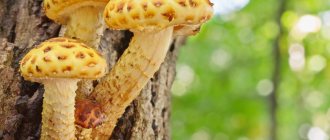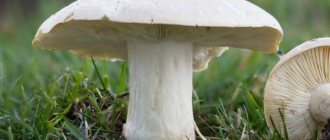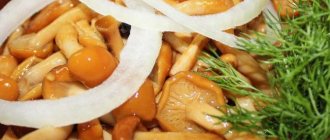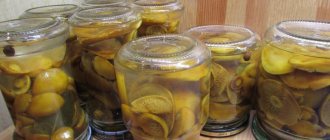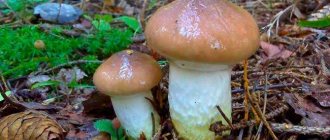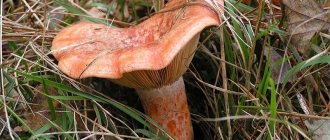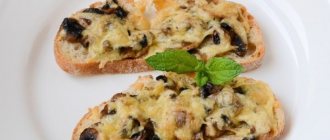Not every mushroom picker knows about such a healthy and tasty mushroom as mokrukha. Most people don't pay attention to it because of its unappetizing appearance. Most species are lilac in color, which is why many mushroom pickers confuse them with inedible ones. The morukha mushroom, regardless of the variety, has a number of medicinal qualities that can normalize the functioning of all systems of the human body.
Description and photo of purple moth
It is also known under these names: Purple mokrukha, Pine mokrukha, Slimy mokrukha, Shiny mokrukha.
Since we said that this mushroom is inconspicuous, it is worth confirming our words with a reliable description. Unfortunately, mokrukha really does not have a bright appearance. In general, distinguishing it from a number of other mushrooms can be problematic. But still, we will try to describe this mushroom in case you come across it during your walk.
hat
So, the cap is the first thing a mushroom picker sees when he discovers purple moth under a deposit of pine needles.
The cap of this mushroom is really nondescript. In diameter it reaches from 5 to 15 cm. Most often it has a gray tint, less often it is gray-brown. If it grows in acidic soils, it can become covered with dark spots, and also acquires a dark purple or lilac hue over time.
If you press on the cap, you will realize that it is very fleshy. If the mushroom is very young, then the cap has the shape of a hemisphere, slightly dome-shaped. However, with age, the edges, as in many other types of mushrooms, begin to rise, forming a kind of cute umbrella.
In the very center of such a cap there is a barely noticeable tubercle. The skin of the mushroom is very smooth. If the sun's rays hit it, the cap becomes glossy. If it grows in the shade, then the cap is covered with a thick layer of mucus. However, it turns out that the mucus itself easily comes away from the pulp. This makes me happy, which means there will be no problems with cleaning.
Leg
The stem of this mushroom is also quite peculiar. Firstly, it has a boiling white color, which is generally not typical for forest mushrooms. Usually they have it brown or yellow.
Many mushroom pickers admit that they recognize purple moth only thanks to the bright leg that can be seen among the dull colors. The height of the leg reaches 13 cm maximum.
As for the minimum size, it is about 4 cm. It has a lemon-yellow tint closer to adulthood. But the upper part is quite bright and white. It often becomes covered with scales, and with gentle pressure it begins to darken.
With age, the leg becomes hollow and is very easy to break. Over time, the mucus from the mushroom cap flows onto the stem, so it is also quite unpleasant to pick up.
Records
Let's talk about the plates that are neatly located under the mushroom cap itself. They have a light gray or even white tint. However, with age, as the fungus grows, it becomes browner in color. In old mushrooms, the plates that have already released spores turn completely black. The plates are quite thick and at the same time branched. They have a characteristic smell, very pleasant, mushroom, but unlike anything else.
Pulp
Purple moth is most valued for its pulp. It has a white or slightly pinkish tint. However, with age, the flesh becomes darker, yellow and even gray.
If you taste this pulp, it will seem sour to you. It has a faint mushroom aroma.
The pulp, when exposed to oxygen, turns pink, then gradually begins to turn yellow.
It is thanks to its pulp that mokrukha has earned the name “molar tooth.” This mushroom was first discovered by the German botanist Jacob Schaeffer. The mushroom became known back in 1774. It belonged to the champignon family. And it was called a molar because of the white color of the stem and pulp.
When the flesh is damaged, it first becomes covered with pink spots, like a disturbed tooth.
Similar varieties
Spruce moth does not have edible and inedible varieties that are similar in description. It shares a number of similar characteristics with the following edible representatives of its family:
- spotted moth: it differs from it in the flesh that turns red when broken and the color of the spore powder,
- purple moth: the mushroom cap of this species has a brighter color.
Representatives with dark caps have some similarities in description with the autumn oiler, which does not have mushroom plates.
Edibility and taste of chickens
In gastronomic terms, the ringed cap belongs to the category of truly absolutely universal and very tasty mushrooms. Fruiting bodies of this variety can be prepared in absolutely any way, but most often the mushrooms are boiled, fried, stewed, pickled and pickled for the winter. Mushroom dishes go very harmoniously with almost any type of vegetable crops, as well as lean meat and a variety of spices.
In some areas, the ringed cap mushroom is very common
As practice and numerous reviews from mushroom pickers show, young mushrooms have higher taste, and with age the flesh becomes unpleasantly hard.
It is important to remember that the fruiting bodies of the annular cap are not used in their raw form, therefore, for preparing salads or cold mushroom appetizers, preliminary boiling is required. Among other things, the excellent nutritional qualities of Turk are complemented by various healing properties.
Including mushroom dishes in the diet helps stabilize blood sugar and cholesterol levels, normalizes blood pressure, and also serves as a preventive measure for certain infectious diseases.
Interesting Facts
According to Mikhail Vishnevsky, a famous Russian mycologist, mokrukha contains much more antibiotics and protein than porcini mushrooms - about 10 times!
Experienced lovers of quiet hunting believe that moths cannot live without butterfish. In nature, this is called symbiosis, when one plant exists not far from another. If you come across boletus slugs in the forest, you can safely look nearby for the lilac caps of slugs.
During the mushroom picking season, it is very important to prevent the mushrooms from overgrowing, so that the fruiting bodies do not dry out and lose all the useful substances. Some mushroom pickers claim that these fruiting bodies do not need to be cleaned before cooking - just rinse under running water and dry
Some mushroom pickers claim that these fruiting bodies do not need to be cleaned before cooking - just rinse under running water and dry.
Spruce weed is undeservedly deprived of the attention of lovers of quiet hunting. If you encounter this species in the forest, collect the slugs in a separate container (so they don't stain the rest of the crop), make a tasty dish, or store them for the winter!
Characteristics of moth species
Only five varieties of edible moth are found in Russia. All of them belong to the fourth category, i.e. suitable for food only after preliminary heat treatment. All these mushrooms will be discussed below.
Spruce or sticky moth has a bluish cap. It is found in families in shady spruce forests or among. It grows more often in the north or center of Russia. Although their flesh is tasty, their fragile texture makes these mushrooms difficult to collect, store, clean, and cook.
The mushroom is distinguished by a significant thickness of the mucous layer on the cap and spores.
Its appearance is unprepossessing: the fifteen-centimeter cap is gray-black, the spore plates are also dark. The leg is dirty white, covered with mucus; over time, only a small dark ring remains of the mucus. Its flesh is tender, not darkening at the break. It has a bright yellow tint. It is considered one of the most useful mushrooms of this species, because. extremely rich in amino acids and carbohydrates.
It is also called pine or shiny wet. It differs from other representatives of the species in the purple color of its cap with upturned edges. Grows in pine forests in temperate climates. The eight-centimeter fleshy cap of young mushrooms has a conical shape and appears to be covered with a thin cobweb. The shiny skin is purple in color, and over time it becomes light brown or reddish.
The fleshy, fibrous, five-centimeter long and often curved leg has a yellow tint and is bright orange at the base. When cut, the flesh turns pink and darkens when cooked.
The spore plates of young specimens are covered with a film and look pinkish-purple; over time they acquire a dark shade. They can be easily separated from the cap. When frozen, the mushrooms take on a copper-purple color.
Its second name is mucous. Grows surrounded by spruce and larches. Dark spots stand out clearly on its small hat. When cut, the mushroom turns red.
In young specimens, the spore plates are sparse and light-colored, then they darken.
The leg is curved, quite dense, painted dirty white with yellow spots. It reaches a length of up to 8 cm. At first it is connected to the cap by a thin film, of which subsequently only a small mucous ring remains. The spore plates have an olive tint. The mushroom requires a long boil before use.
Often, because of the fluff covering the light cap, it is also called fleecy. It is smooth, divided into shallow grooves along the edges. Orange-brown plates descend onto the stem. The cap sometimes reaches a diameter of up to 10 cm. The flesh has different shades of ocher color
, and when dry it acquires a brown or pink-wine color.
The straight leg with a slight thickening in the middle is painted in the same colors as the cap. The spores are dark brown. The mushroom usually grows in protected forests, in the vicinity of pine or fir trees. Appears en masse in the fall, often in large groups.
The size of the cap does not exceed 6 cm. At first it resembles a hemisphere with a drooping edge, and then it opens and turns from purple-pink to bright red. The spore plates are succulent and sparse, going through color stages from white to black.
The six-centimeter leg is white on top and brown underneath, and has a roller-shaped ring on it. The mushroom flesh is white and dark underneath. The spores are grey. Thanks to the rare beauty of the combination of a pink cap and dark spore plates, it differs from other lamellar mushrooms with which this moth cannot be confused.
Contraindications for use
To avoid negative effects on the body, you should not eat mushrooms alone. Mokrukha, although rich in health benefits, leading doctors recommend using the product in small quantities, in harmony with a light side dish or vegetable salad.
The use of mushrooms is strictly contraindicated if there are restrictions, namely:
- gastrointestinal diseases, including stomach ulcers;
- pregnancy;
- during lactation;
- children under 13 years of age;
- the presence of individual intolerance;
- allergic reaction;
- renal failure;
- gout;
- diseases of the heart and blood vessels.
Cooking recipes
Bachelor sandwiches
Even a child can cope with the preparation. You should prepare:
- A couple of toasted slices of bread;
- Fresh mokrukha (no more than 10 pieces);
- Hard cheese – 10 g;
- Butter 1 tbsp;
- A little chopped dill and parsley;
Preparation
- First of all, after washing the mushrooms, you should remove the jelly-like film from them using a knife.
- Now the pulp is cut into slices and placed in a dry frying pan to evaporate for a couple of minutes. After the required time, add butter and continue frying for 3-4 minutes.
- During this time, the bread is toasted in a toaster.
- Spread butter on the bread, apply a thin layer of fried mushrooms, sprinkle with cheese and herbs.
- The sandwiches are placed in the microwave for a few minutes to melt the cheese.
In Korean
This side dish will please everyone without exception. To prepare the dish you need:
- Wet about 1 kg;
- Salt, ground black pepper;
- Onion - a couple of heads;
- Korean carrots – 200 gr;
- Sunflower oil – 2 tbsp.
Preparation
- The pulp is washed, cleared of mucus, placed in a saucepan and boiled over medium heat.
- After some time, the water is drained, the pulp is cut into cubes, placed in a frying pan with sunflower oil and fried for 10 minutes.
- Add chopped onions to the mushrooms and simmer for another couple of minutes until done.
- Combine mushrooms and Korean carrots.
Omelette
This delicious recipe is suitable for all lovers of mushroom dishes. Need to stock up:
- Purple fly - 1 kg;
- Prunes – 150 gr;
- Semi-dry wine – 150 g;
- Tomato;
- Chicken eggs – 5 pieces;
- Greenery;
- Salt;
Preparation
- The pulp must be cleared of mucus, washed and chopped, and fried until the liquid evaporates.
- Prepare prunes. If it is dry, pre-soak it for half an hour. The finished prunes are finely chopped and sent to the mushrooms.
- After a couple of minutes, add wine to the pulp in the frying pan and simmer until the liquid evaporates. Salt and pepper to taste.
- Cut the tomato and add it to the mixture.
- Using a whisk, beat chicken eggs, adding a little baking powder to them. Eggs are added when the liquid has evaporated. In this case, the pan must be set aside from the heat for a minute to cool. The egg mixture is poured into the mushroom mixture, stirred, and returned to the heat.
- In 5 minutes the omelette is ready. If desired, sprinkle it with herbs. A very tasty dish when served warm.
You might also like:
Camelina mushrooms: benefits and harm.
Recipes for cooking saffron milk caps How to pick mushrooms correctly - cut the stem or pull it out?
Chaga - beneficial properties and uses. Chaga - contraindications and side effects
Mokrukha is a mushroom that is undeservedly forgotten by mushroom pickers and is practically not collected. But in vain - when properly prepared, the fruit tastes like butter or even a porcini mushroom. However, you need to collect moths correctly, knowing all the intricacies of each type.
Mokrukha is a mushroom that is undeservedly forgotten by mushroom pickers and is practically not collected
Morocha mushroom is an edible species belonging to the Gomphidiaceae family. The fruit got its name due to the special structure of the cap and its covering.
The mokruha's cap is brownish-violet in color, depending on the variety, and has a convex shape, with a slight depression in the center. It can reach up to 15 centimeters in diameter, which characterizes the mushroom as a fairly large organism. The cap flesh is juicy, fleshy and does not change color when pressed or damaged. In young fruits it is covered with a thick layer of mucus, which forms at high air humidity.
The plates located at the bottom of the cap are initially white, but as the fruit grows they can become dark, almost black. They, just like the cap, are covered with a mucous blanket. During mushroom picking, it remains on the stalk.
The spore powder is also brown in color, but is practically invisible to the human eye.
The leg is long, massive, about 12 centimeters long and three centimeters thick. The flesh of the leg is slightly yellow at the base, and on top it changes color to a gray or beige shade.
In terms of their taste characteristics, mokruki are most similar to butter or white
mushrooms. When stewed or otherwise cooked, the juicy pulp releases enough juice so that the final dish is not only aromatic, but also “moist.” Mokruhi are suitable for pickling, frying, stewing, and freezing.
Autumn honey fungus, or true honey fungus (Armillaria mellea)
Season: August-November.
Autumn honey fungus, or real
Habitat: coniferous and mixed forests, on coniferous wood, stumps, fallen trees. They grow in huge groups. One of the most favorite mushrooms.
Description of the species:
- the cap is 3-10 cm in diameter, at first round-convex, later spread out, sometimes with a tubercle in the middle. A distinctive feature of the species is its yellow-brown or brown-reddish cap with numerous small brown scales. The edges of the cap are striped, first curled inward, later straightened out. In young specimens, the cap is connected to the stalk by a white membrane, which later remains in the form of a ring in the upper part of the stalk;
- the stalk is 4-12 cm high and 6-15 mm thick, dense, cylindrical, at first flocculent-scaly, later almost bare, slightly widened near the base. In the upper part of the leg there is a well-defined ring with a fringed edge. The stem is usually exactly the same color as the cap;
- the pulp is dense, white, does not change color when broken, with a pleasant smell and taste;
- the plates are sparse, adherent, slightly descending along the stalk, thin, frequent, whitish-yellowish in young specimens, brownish in maturity, often covered with rusty spots.
Variability: the cap can be light (yellow-brown) in dry weather, but in damp and cold weather its color darkens (to dark brown).
Similarity with other species: autumn honey fungus is similar to the inedible honey fungus (Hypholoma capnoides), which is distinguished by very frequent plates of grayish or gray-brown color.
Hypholoma capnoides
It also looks like brick-red honey fungus (Hypholoma sublateritium) with frequent olive-brown plates with a purple tint.
Brick red honey fungus (Hypholoma sublateritium)
Edibility: edible, classified as category 3.
Cooking methods: frying, marinating, boiling.
Characteristic features of the spruce fly mushroom
Most often in forests, pine moth grows in small groups. It is distinguished by the presence of a constantly wet cap.
Appearance and photo
The mushrooms are medium in size. Young specimens are light-colored, with a lot of sticky mucus. Mokruha is distinguished by sparse and rather dense partitions, through which you can see the light flesh.
You may be interested in:
What does a satanic mushroom look like and is it edible or not (21 photos)? The Satanic mushroom, or Satan, is a rare species that mycologists classify as poisonous. The mushroom is considered...Read more...
Structure and species differences
Mokruhi are divided into several types, but their structure is similar:
- The hat can have different colors depending on the type. Most have a muted brownish tone. The diameter can vary from 6 cm to 14 cm. There is a layer of mucus on top, the skin is soft and easily separated. The young mushroom is convex in shape, while the old one has a flat cap.
- Leg – from 10 cm to 14 cm in height. When pressed, the color darkens. At the junction with the cap there is a cushion of mucus. With age, the leg becomes darker, even black.
- The plates are located at a great distance from each other, you can view the pulp. Young specimens have a lighter shade, which changes over time. The plates are quite thick and dense, covered with mucus.
- The flesh may be pink, yellow or white, depending on the species. Old mushrooms are distinguished by the gray color of this pulp. The aroma is difficult to detect. Taste with sourness.
Place of distribution and collection rules
Found in the northern region of the Eurasian continent. In Russia, mokruha spreads throughout the entire forest zone. The most common spruce fly grows near spruce and pine trees in coniferous, deciduous and mixed forests. Found in thickets and near moss. Sometimes it can be found next to a birch or pine tree. You can find a moth in absolutely any forest. Mokruha is absent only in the North and Far South of Russia.
Mokruhi can be found in plantings and pine forests from early summer to mid-autumn. The best time to harvest is the second half of September. Look around the chalky soil and hills; mushrooms may be hiding among a group of boletus mushrooms.
The mushroom should be cut off in the middle of the stem, the remainder should be covered with pine needles or leaves. You should not collect mushrooms that grow close to the road, chemical plants, or military training grounds.
Remember! You definitely need to pay attention to the age of the moth. Young mushrooms have more useful substances and are light in color.
Eating
The mushroom belongs to the 4th category of edibility, so it can be eaten only after boiling for 15 minutes. Only young specimens can be consumed without harm; the rest accumulate a toxic substance. The fruits are pickled, dried, salted, fried and boiled. The pulp has a rather pleasant smell and taste. It should be borne in mind that during the heat treatment the color of the mushroom changes.
Difference from false, inedible mushrooms
Some types of moths are visually similar to baby goats and butterflies. The mushroom has no poisonous counterparts, so a mistake when collecting will not lead to dire consequences.
There are special features that will help distinguish Mokrukha from similar mushrooms:
- Sparse white plates under the cap, which darken near the stem.
- The presence of a pronounced mucous layer in young specimens.
- Older specimens have a thin ring of mucus on the top of the stalk.
Collection rules
To avoid negative consequences, it is important to adhere to the basic rules for collecting moth:
The cut of the mushroom must be made in the middle of the stem, then cover the mycelium with pine needles. It is strictly not recommended to collect moths near highways, military training grounds or chemical plants. It is best to give preference to young specimens, since old mushrooms tend to accumulate toxic substances. It is equally important to check the fruiting body for worms. Immediately after collection, it is important to heat-treat the mushrooms: at room temperature, the mushrooms quickly deteriorate. Can be stored in the refrigerator for no more than 24 hours. In this case, the fruiting bodies should be kept in clay or enamel containers.
Recipes for making purple mokrukhs
Purple mokrukha is suitable for almost any cooking method. But before frying, pickling or otherwise preparing purple moth, does it need to be pre-treated?
- Fresh fruiting bodies must be prepared within 24 hours after collection; they are not stored for long and quickly begin to deteriorate.
- Before cooking, the mucous film on the cap must be removed from the yellowlegs, and then rinsed in cold water.
Important! There is no need to soak purple mushrooms, unlike many other mushrooms, they can be immediately subjected to further heat treatment
Boiled mokruhi
The fastest way to cook autumn yellowlegs is to simply boil it in salted water. The peeled and washed caps and legs are placed on the stove and boiled for only 15 minutes. The water is then drained, and after cooling the mushrooms are added to the salad, eaten as a snack, or subjected to further processing.
Fried mokruhi
Yellowlegs fried with potatoes, meat or vegetables can delight you with a pleasant taste. The boiled caps and legs are placed in a frying pan greased with vegetable oil and fried along with onions or chopped potatoes for as long as necessary until the side dish is fully cooked. There is no need to check the yellowlegs themselves; they do not require long frying using special technology.
Salty mokruki
The classic method of preparation is cold pickling of purple mushrooms, which allows you to preserve mushrooms for the winter. The recipe looks very simple - pre-boiled caps and stems are placed in layers in a sterile glass jar. Each layer should be generously sprinkled with salt; you can also add spices to the pickling, for example, dill seeds and pepper, garlic and cloves.
The filled jar is covered with folded gauze along the neck and pressed down with pressure. After a few days, the mushrooms should completely cover the released juice, and after another 40 days, the pickles become ready to eat. During the salting process, the gauze on the neck of the jar needs to be changed from time to time to prevent mold from growing on it.
Classification
Classification of poisonous mushrooms
If edible mushrooms are classified according to several criteria (in particular, structure), then poisonous mushrooms have their own system of division into groups. According to how they affect the human body, there are 3 groups of poisonous mushrooms:
- Causes food poisoning (tiger row, satanic mushroom, tin entoloma).
- Affects the central nervous system (panther fly agaric, purple ergot).
- Cause severe poisoning with possible death (pale toadstool, stinking fly agaric).
All three categories are dangerous, but the mushrooms that are included in the third group are the most insidious. The fact is that for the first time after eating them, a person may not feel any changes. Some toxins begin to act in slow motion, thereby delaying the moment of seeking medical help.
There is another classification based on the content of certain toxins:
- Cyclopeptides. The most dangerous poisons. Signs of intoxication appear only after a day or two. Then feeling unwell may stop for a couple of days. A false feeling of recovery arises, after which the person’s condition deteriorates sharply and rapidly. Toxins hit the liver the hardest.
- Cortinarine and orellanine. Poisons affect mainly the stomach and kidneys. Causes pain, gastrointestinal upset and a strong feeling of thirst. Their danger lies in their delayed manifestation - after a week or two.
- Monomethylhydrazine. The toxin, unlike the previous ones, manifests itself very quickly - within a matter of hours after entering the body. However, it affects organs and systems no less.
- Koprin. The toxin has a negative effect only if it is mixed with alcohol shortly after entering the body. As a rule, indigestion and tachycardia occur.
- Muscimol and ibotenic acid. Causes poisoning and general malaise.
- Muscarine. A couple of hours after entering the body it causes fever without increasing body temperature.
- Bufotenin. General malaise only occurs when eating large quantities of mushrooms.
Also included in a separate group are mushrooms that can cause allergies.
Use in cooking. Recipes
In Europe, spruce moth is considered a tasty product, and in China it is consumed more often than other mushrooms; in our country it is not very popular. Sticky mokrukha can be salted, fried and pickled. It is also suitable for drying. It is used to make soups, sauces, casseroles, and sandwiches. Spruce moth can be added to salads, fried or boiled. It will give the dish a special taste and make it visually attractive.
They prefer to use it as an addition to main dishes, mixing it with other mushrooms. It goes well with meat or fish if fried or stewed with other more flavorful foods.
Before use, freshly picked mushrooms are sorted and damaged mushrooms are discarded. It is advised to remove all film and mucus. To do this, you need to cut the leg in half lengthwise up to the cap, then it will be very easy to remove the unnecessary skin.
Mushroom pickers recommend putting mushrooms in water for a few minutes before cleaning. Then the layer of mucus will be removed even easier. The fingers darken during cleaning, but after the procedure they can be easily washed with soap and water. Then the mushrooms are washed and cooked for about 15-20 minutes. After heat treatment, the product darkens; this color change does not affect the taste of the product.
If mushrooms are fried, do not add a lot of oil, because the pulp will give juice, which is enough for subsequent processing. For those who like crunchy and strong mushrooms after frying, mokruki are not suitable. You shouldn’t simmer sticky mokrukha for too long, because the flesh will become tough.
How to pickle Mokrukha
Mushroom pickers advise pickling slugs along with other mushrooms. So, for 1 moth there are 8-10 butterflies or cobwebs.
The following marinating recipe has worked well:
- Peeled mushrooms should be placed in a deep container and filled with water, adding a pinch of salt and the same amount of citric acid. The mixture is brought to a boil and cooked for 15-20 minutes.
- The water is drained and the mushrooms are washed. Now they are ready to marinate.
- Pour 1 liter of water into the pan and add 80 g of sugar, 5 black peppercorns, 2 cloves, 50 g of salt, 100 ml of 6 percent vinegar and one laurel leaf.
- The resulting marinade is brought to a boil and 2 kg of prepared mushrooms are added to it. Cook everything together for 20 minutes.
- When the mushrooms sink to the bottom and the water becomes clear, they are transferred along with the marinade into pre-prepared jars, filling with liquid so that it completely covers the mushrooms with butter.
- Add 1 tablespoon of sunflower oil to each jar and close with nylon lids. Store pickled mushrooms in the refrigerator.
Below are other recipes using wet glue:
Korean snack
Very fast and tasty.
To prepare this dish, you need to carefully separate the mushrooms from the film and boil. Then the mushrooms are fried along with chopped onions
Korean carrots are added to the finished products, preferably not spicy ones. The dish is seasoned with olive oil.
Peppers stuffed with mushrooms and buckwheat
Most housewives are accustomed to stuffing bell peppers with rice and meat. You can diversify the menu by replacing the filling with buckwheat and spruce moths. To do this, you need to boil and fry the mushrooms a little. Then they should be mixed with raw buckwheat, salt and pepper to taste. The resulting mixture is used to stuff peppers, which must be seeded in advance. Vegetables are stewed in water with the addition of tomato paste, or fried with fresh tomatoes.
Bachelor Sandwiches
This is a very simple recipe that even a child can handle. You need to fry a few slices of bread and spread a little butter on them. Peeled mushrooms are boiled and fried in a frying pan for 3-4 minutes. Place toasted mokrukha on the bread and sprinkle grated cheese and herbs on top. Sandwiches should be placed in the microwave for 1-2 minutes to melt the cheese.
Due to the low calorie content and large amount of useful substances contained in this product, nutritionists recommend spruce moth for daily use. In terms of protein content, it can become a good competitor to meat dishes.
Medicinal uses and beneficial properties of the mushroom
Slug is considered one of the most useful types of mussels, because it is very rich in carbohydrates and amino acids. It contains vitamins of group B, as well as C and E, necessary for humans. It contains chitin and fiber. All these substances have a beneficial effect on the human body, namely:
- increase body tone;
- improve memory;
- fight fatigue;
- promote the process of hematopoiesis.
This product is especially useful for people who suffer from headaches, chronic fatigue, and diseases of the nervous system.
A tincture is made from spruce moth, which is used as an antimicrobial agent. It has a strong suppressive effect on the proliferation of various pathogenic microorganisms, including staphylococci. It is used to treat skin diseases, sinusitis, wound healing and rinsing the mouth. However, such a medicine has not undergone clinical trials, its effect has not been scientifically confirmed.
Traditional healers offer the following recipe for tincture:
- The wet ones are cleaned of dirt, but not washed. This will preserve the mucus, which contains substances beneficial to the body.
- Then they are finely chopped and placed in a glass container. There is no need to compact the mushrooms to the top.
- The product is poured with high-quality vodka or alcohol and placed in a dark place for 2 weeks. The composition should be infused at room temperature. It is necessary to shake it periodically.
- After the specified period of time, strain the tincture using gauze and squeeze out the mushrooms.
- The resulting product is stored in a place protected from sunlight and also at room temperature.
Take it 20 drops three times a day, washed down with water or added to liquid. Children under 12 years of age are allowed to take the medicine. Then the dosage is reduced to 3-7 drops, depending on age. The tincture is also used to wipe sore spots on the skin.
Slug extract is well known to experienced cosmetologists. It can be found in some masks and creams. Such products help restore youth and freshness to the skin. Masks with an extract of this mushroom can tighten pores, eliminate oily shine and remove flaking.
Masks made from crushed spruce dust are good for hair that has split ends. It is useful to rinse weakened and dull hair with a decoction of them. Regular use of this mushroom will even help you cope with baldness.
Similar species
Naturally, the purple moth is not the only one of its kind. She has a lot of doubles, as well as simply similar species. It is believed that the purple moth is a common subspecies of a huge family. Let's get to know all its representatives.
Spruce weed
Spruce damp. The most common species in the Russian Federation. It is an edible mushroom. The cap reaches a maximum diameter of 13 cm and is quite fleshy. In young mushrooms it is spherical, then becomes flat.
This mushroom is characterized by a large amount of mucus that forms on the cap. Like the purple species, it likes to settle in pine forests and forms mycorrhiza with this tree.
The leg is white, then becomes gray over time. It reaches a height of 11 cm. Gradually, gray scales form on the leg, which recede with old age.
The mushroom is distributed throughout the central part of Russia, also in the south. Found in Europe and the USA. It has a delicious aromatic smell, making it ideal for cooking.
Wet pink
Pink mokrukha is a very beautiful and remarkable mushroom. However, many mushroom pickers, seeing its appearance, try to avoid this mushroom, believing that it is strongly and poisonous.
The mushroom itself is small, reaching a maximum of 6 cm in diameter. The shape of the cap is hemispherical, but then opens up to a fairly convex and at the same time flat cap.
The color is brick pink, however, becoming browner with age.
The plates are descending and boiling white. The leg reaches a height of 8 cm, and a volume of up to 2 cm. It has a cylindrical shape and tapers towards the base. It has a white tint with gold flecks.
It has become widespread in the central zone of Russia, as well as in Poland, Belgium, Hungary and Bulgaria.
Mokrukha spotted
The spotted moth got its name largely because its cap and stem are covered with small purple spots. This mushroom looks quite strange, sometimes comical.
As for its description, the mushroom itself is small. It reaches 7 cm in diameter and three cm in width. The hat is quite convex, but dense. The surface is covered with a weak layer of mucus, which is very harmful. The plates are quite rare and branched.
The leg reaches 11 cm in length, up to one and a half cm in circumference, is quite thin and often breaks. The flesh of this mushroom has a yellow tint, and is white when young.
Distributed throughout Eurasia, especially in the Central and Eastern parts. And also in North America.
The mushroom is conditionally edible, however, due to its not very pleasant smell, people prefer not to touch it.
Swiss wetweed
The Swiss weed is called the double of the purple wetter. This is true. These mushrooms are very similar in color, but the Swiss mushroom has a browner tint. The cap of this mushroom is convex, quite dry and ocher-colored.
It reaches 10 cm in diameter.
The leg also has a brown tint and reaches a height of 10 cm. It is 1.5 cm in diameter. The pulp is quite dense and fibrous. However, if damaged, it takes on a reddish tone.
Most often this mushroom grows singly or in groups.
The place of growth is easy to determine, since it is already stated in the name. But they are also found throughout Russia.
Answers to common questions
The most common questions include questions about edibility, cooking rules and heat treatment.
What happens if the bitters are not soaked before cooking? If the fruit body is not soaked and processed, then its taste will remain bitter from the juice and an unpleasant acrid aroma. This can cause digestive system disorders.
Is it possible to get poisoned by bitters? You can be poisoned by bitters if they are not soaked and treated in boiling water before consumption.
What to do if bitterness remains after cooking? Bitterness after cooking remains exclusively with old mushrooms. Experts do not recommend using such fruiting bodies. If after careful processing the bitterness does not go away, then it is better not to eat such fruit parts.
Bitters are one of the most common types of mushrooms that grow in the forest and are unpretentious to weather conditions, so you can always find them. In this regard, they are considered a good alternative to other types
However, it is very important to be able to distinguish between false and inedible types of mushrooms, since there are a lot of varieties similar to bitter mushrooms
